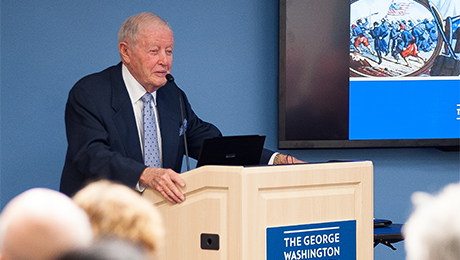It all started with a small manuscript. Albert H. Small was walking through the streets of New York waiting for his fiancée to finish work. He strolled past several store windows before poking his head into a book dealer’s shop. It was his first time browsing through old books, but one caught his interest—“just a little thing,” he described. It was a manuscript detailing the way Washington, D.C., was laid out, which he promptly purchased.
This marked the beginning of Mr. Small’s historic Washingtoniana collection. It has grown to include hundreds of rare papers, maps, drawings and other artifacts chronicling the history of the nation’s capital. Mr. Small donated the collection to the George Washington University in 2011, and it will be permanently displayed in the historic Woodhull House when the new museum opens in 2014.
Mr. Small shared the story of his collection at the Albert H. Small – George Washington University Washingtoniana Symposium and Luncheon on Tuesday at the Elliott School of International Affairs. The event celebrated his gift to the university and highlighted the work of Gabriella Angeloni, B.A. ’13, senior Andrew Kaiser and graduate student Maggie Leak, who researched pieces from the collection for a catalog that curator James Goode, Ph.D. ’95, will publish when the museum opens.
The symposium was followed by a luncheon, in which GW President Steven Knapp and John Wetenhall, the director of the new George Washington University Museum and The Textile Museum, gave brief remarks. Dr. Wetenhall said the new museum is central to GW’s academic mission and its goal will be to use objects as gateways to cultural understanding.
During the symposium, former trustee and current Chairman and President of the National Trust for the Humanities Robert G. Perry, B.S. ’70, welcomed the audience and introduced Mr. Small. Mr. Small said he hopes his donation will be used to promote academic growth and scholarly work.
“Many people today don’t know too much about the history of Washington,” Mr. Small said. “This museum is going to make that information available.”
Provost Steven Lerman discussed how important the collection is for creating learning experiences at the university.
“One of my aspirations for this museum and this collection, much like Albert articulated, is making it accessible to our students and faculty in ways that encourage them to listen to the stories and construct the stories of our city’s history from these artifacts,” Dr. Lerman said.
Dr. Goode presented insights from 13 new pieces recently acquired into the collection. He shared unique documents, including a letter in which George Washington discussed the need to find architects to build on Washington, D.C., and criticized Pierre L’Enfant. Dr. Goode also showed lithographs of the National Washington Monument from 1885, a bird’s-eye view of the Capitol from 1850 and the main buildings of the first two colleges in Washington, D.C., circa 1830—Georgetown College and Columbian College, which later became the George Washington University.
Following Dr. Goode’s presentation, Professor and Chair of the Department of History William Becker introduced two of five history undergraduate students who conducted research for Dr. Goode’s book.
“One of Albert’s goals was to make sure students were heavily involved in the use of his materials. The experience our students had meets his goal of having the collection be part of the fabric of university life,” Dr. Becker said.
Ms. Angeloni presented findings on the lithograph, “Phoenix Line, ‘Safety Coaches’… Running between Washington and Baltimore,” made circa 1831-1834. She described spending hours in the newspaper room at the Library of Congress to better understand the time period in which the piece was made. Mr. Kaiser discussed the history and background of “Robert Knox Sneeden Witnesses the Destruction of Manassas Junction,” a watercolor from 1862.
Museum Studies Professor Laura Schiavo, Ph.D. ’03, then introduced Ms. Leak, who shared her art historian’s approach to researching a hand-drawn map created by John Frederick Augustus Priggs in 1790.
After Ms. Leak spoke, Dr. Lerman thanked the students for bringing the “true” history of Washington, D.C., to the audience, and congratulated the students on their work on the collection
“This is exactly what I always thought might happen if we brought a collection as wonderful as Albert Small’s together with our students,” Dr. Lerman said.


